Massachusetts hospitals serve communities by providing medically necessary care 24 hours a day, seven days a week. To meet their mission, hospitals are open and accessible to all members of the public. As such, staff, patients, and family members of patients may unfortunately be subject to incidences of violence within the hospital setting despite hospitals' best efforts.
Massachusetts hospitals have been, and remain committed to, working with their staff and patients to review internal systems, develop policies and programs to prevent violence in the workplace, and respond to each and every incident. In Massachusetts, the state’s Executive Office of Health and Human Services (EOHHS) and the Executive Office of Labor and Workforce Development (EOLWD) have issued guidance and information for entities like hospitals to develop workplace violence prevention and crisis response plans. The main accrediting agency for hospitals – the Joint Commission – recognizes the need for facilities to protect against workplace violence; it has issued guidance and standards that hospitals have used to update existing practices. In addition, federal agencies such as the Centers for Disease Control and Prevention’s (CDC’s) National Institute for Occupational Safety and Health (NIOSH) and the U.S. Occupational Safety and Health Administration (OSHA) have issued guidance and information that hospitals and other providers review regularly.
Despite all the information available, and the extensive work that hospitals and other providers have done, new challenges and safety concerns continually arise. Through this webpage, the Massachusetts Health & Hospital Association (MHA) endeavors to provide its members resources they may use to supplement and improve their own workplace violence prevention plans. Listed below are some key resources you may find informative on the issue. Overtime, MHA will update this webpage with additional resources.
 Massachusetts Laws and Regulations
Massachusetts Laws and Regulations
Chapter 3 of the Acts of 2013 – Approved in February 2013, the state law outlined the general requirements on developing workplace safety standards as well as directed the Executive Office of Health and Human Services to create regulations outlining expectations for EOHHS contracted entities.101 CMR 19.00: Workplace Violence Prevention and Crisis Response Plan – The February 2015 EOHHS regulations govern the procedures and criteria for workplace violence prevention and crisis response plans within EOHHS contracted entities.
 Massachusetts Executive Orders
Massachusetts Executive Orders
Executive Order 511 established the Massachusetts Employee Safety and Health Advisory Committee.
Summary of Standards and Recommendations for Practical Strategies to Improve Workplace Safety
Annual Report & Recommendations for State Initiatives to Improve Worker Health & Safety
 National and Other Federal Guidance and Related Information:
National and Other Federal Guidance and Related Information:
The Joint Commission – The Joint Commission is the premier accrediting organization for hospitals and has issued two guidance documents on workplace safety:
June 2010 – Sentinel Event Alert – “Preventing violence in the healthcare setting”
August 2014 – Quick Safety Guidance – “Preventing violence and criminal events”
 Occupational Safety and Health Administration (OSHA)
Occupational Safety and Health Administration (OSHA)
OSHA Workplace Violence Prevention and Related Goals
OSHA Roadmap for Healthcare Facilities
OSHA Inspection Guidance for Inpatient Healthcare Settings
 General Industry Guidance
General Industry Guidance
Minnesota healthcare interests – from the state’s Department of Health to the Minnesota Hospital Association, among others – created this “gap analysis” to help healthcare facilities implement best practices to prevent violence within hospitals.

AHA Issue Brief: Building a Safe Workplace and Community — Violence Mitigation in a Culture of Safety
This issue brief, the third of four in the series, examines how hospitals’ violence mitigation efforts can fit effectively into an organization’s culture of safety strategy.
»Full Article
AHA Issue Brief: Building a Safe Workplace and Community — Providing Trauma Support to Your Workforce Following an Incident or Threat of Violence
This issue brief examines trauma support for hospital and health system team members.
»Full Article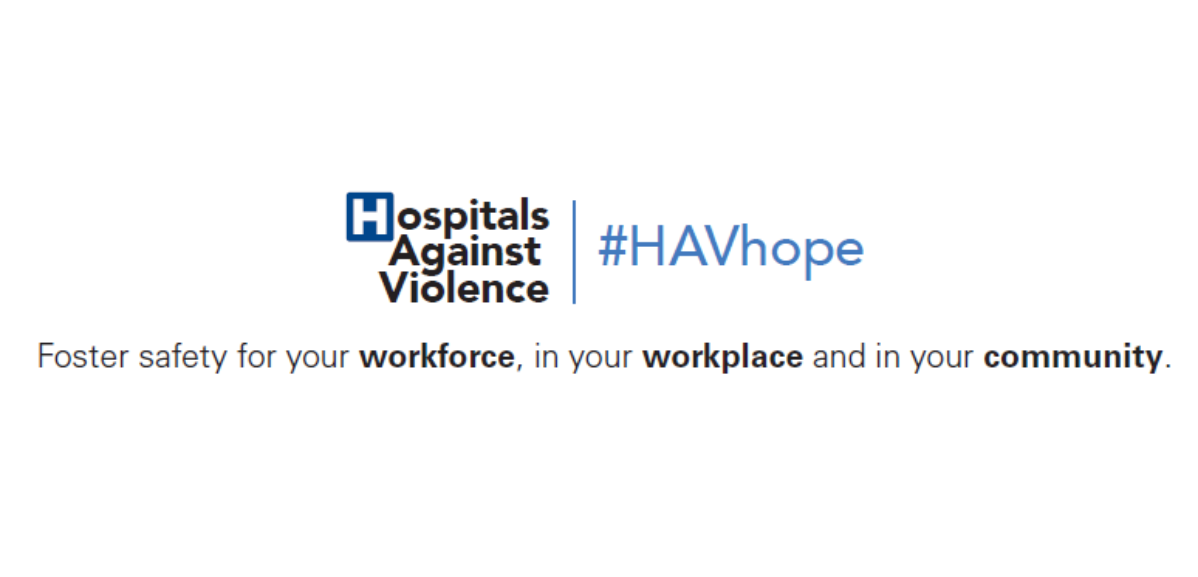
AHA Building a Safe Workplace and Community: A Framework for Hospital and Health System Leadership
The American Hospital Association’s Hospitals Against Violence (HAV) initiative hosted the American SAHA’s Hospitals Against Violence framework helps guide hospital and health system leadership address the issues of violence in their workplaces, with an emphasis on educating and protecting the workforce.
»Full Article
AHA Issue Brief: Building a Safe Workplace and Community — Mitigating Risk of Violence
This issue brief examines risk mitigation and marks the first in a series that expand on culture of safety, violence intervention, trauma support and risk mitigation.
»Full Article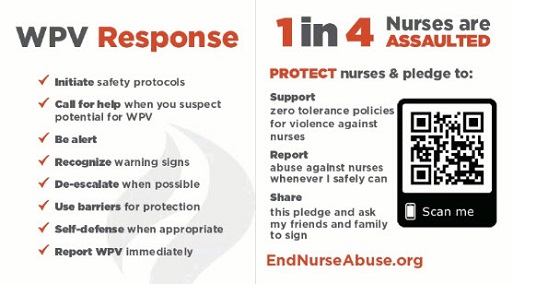
End Nurse Abuse Resource Guide
Download, read and share ANA’s #EndNurseAbuse Resource Guide and commit to reporting all abuses that you encounter. ...» Full Article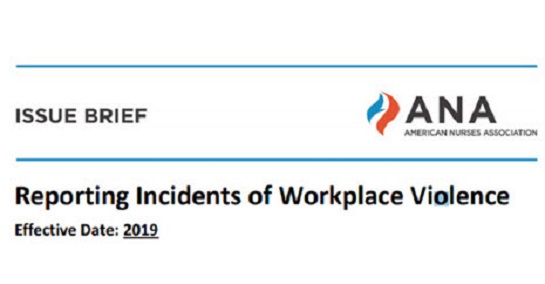
ANA – Issue Brief – Reporting Incidents of Workplace Violence
Reporting Incidents of Workplace Violence Effective Date: 2019 Overview The rate of violence against health care workers has reached epidemic proportions. According to a 2012 report by the U.S. Government Accountability Office (GAO), health care workers in inpatient facilities experienced workplace violence-related injuries requiring days off from work at a rate at least five to 12 times high...» Full Article
Human Trafficking Response: Resources for Health Care Professionals
The American Hospital Association’s Hospitals Against Violence initiative joins the National Human Trafficking Training and Technical Assistance Center (NHTTAC) and HEAL Trafficking to provide key resources and information on how hospitals and health systems can combat human trafficking in their communities. Read more… ...» Full Article
Webinar-Up-Close Look at Violence & Violence Prevention
Healthcare workers are often the target of verbal and physical violence from patients. Hospitals, aware of the trend, are continually making strides to protect their workforce. Recently, a national webinar hosted by the AHA’s Health Research and Educational Trust (HRET) featured MHA and Harrington Healthcare System’s Elise Wilson, R.N., who was violently attacked while caring for a patient. ...» Full Article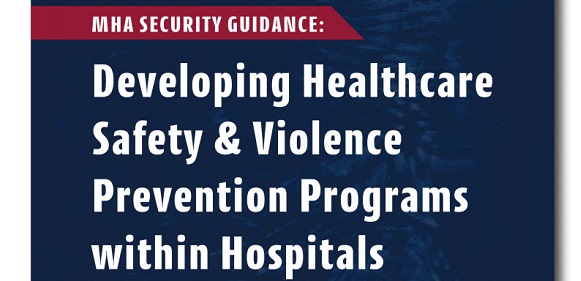
MHA’s Efforts to Address Healthcare Violence
Over the last year, MHA convened an interdisciplinary group of hospital staff to identify strategies to address incidents of violence in the workplace. This group consisted of nursing staff, security professionals, risk managers, and others. Its intent was to develop statewide standards and policies that provide a baseline for safety practices and to support adoption of said standards in every h...» Full Article
HRET Culture of Safety Top Ten Checklist
This Culture of Safety Top Ten Checklist includes steps to review current interventions or initiate new ones to ensure a culture of safety in your facility....» Full Article
HRET Culture of Safety Change Package
This change package is a summary of themes from the successful practices of high performing health organizations across the country. It was developed through clinical practice sharing, organization site visits and subject matter expert contributions. This change package includes a menu of strategies, change concepts and specific actionable items that any hospital can choose to implement based on n...» Full Article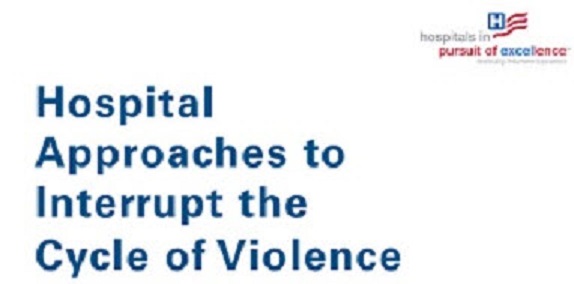
What is the Cycle of Violence?
According to the AHA/ACHI Hospital Approaches to Interrupt the Cycle of Violence guide, exposure to violence significantly increases the likelihood of an individual being a perpetrator of violence or experiencing repeated violent injury in the future, creating an ongoing cycle of violence. Prevention poses a challenge because violence occurs as part of a cycle of learned behaviors that are furt...» Full Article
Through the Eyes of the Workforce: Creating Joy, Meaning, & Safer Health Care
Workplace safety is inextricably linked to patient safety. Unless caregivers are given the protection, respect, and support they need, they are more likely to make errors, fail to follow safe practices, and not work well in teams. A new report from the Lucian Leape Institute looks at the current state of health care as a workplace, highlights vulnerabilities common in health care organizations, di...» Full Article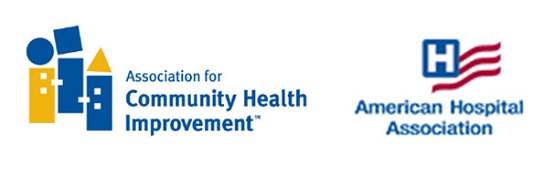
American Hospital Association’s Hospital Against Violence Campaign
The AHA 's Hospitals Against Violence Hope (#HAVhope) Friday is a digital media campaign focused on bringing national attention to ending all forms of violence and encouraging hospitals, health systems and community organizations to stand together against violence. Become a supporter by tweeting or submitting a photo that highlights your efforts of combatting violence in the community you serve....» Full Article
AHA’s Combating Violence in Our Communities and Our Hospitals
Our communities must work together to combat all forms of violence, now viewed as one of the major public health and safety issues throughout the country. Community action programs such as those being undertaken by our nation’s hospitals and health systems (alone and with others) are needed now more than ever to help address violence and the toll it takes on our communities and hospital collea...» Full ArticleTranslate »
